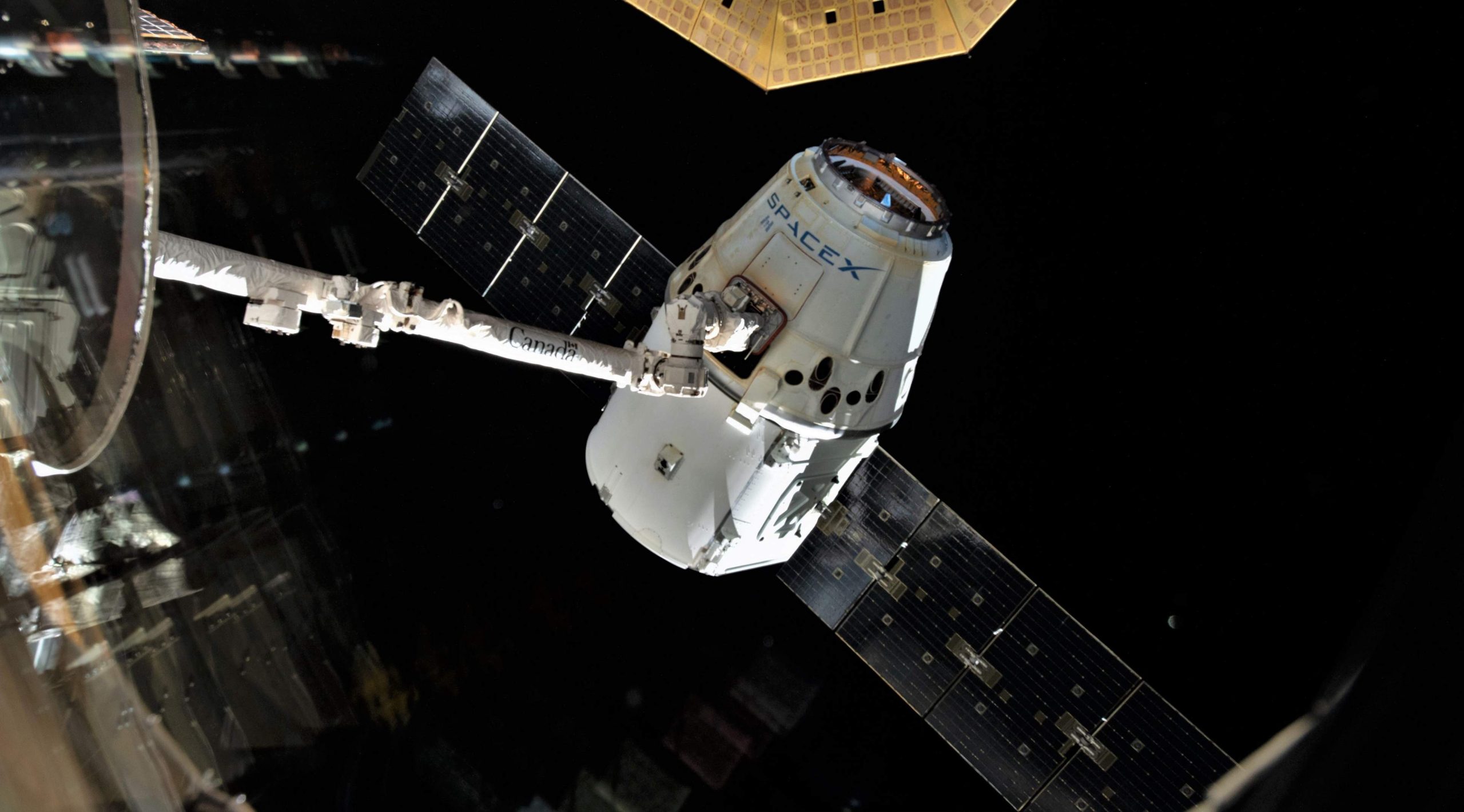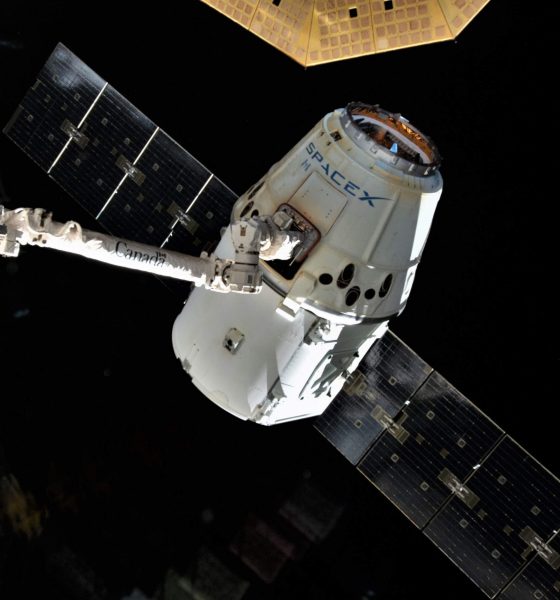

News
SpaceX’s Cargo Dragon spacecraft nears space station with 2.5 tons of cargo
Following a successful May 4th launch atop Falcon 9, SpaceX’s latest Cargo Dragon spacecraft is just a few hours away from starting its International Space Station (ISS) berthing sequence.
Scheduled to begin around 5:30 am EDT (09:30 UTC), SpaceX operations staff will command Dragon to continue a cautious ISS approach. Several hours later, the spacecraft will be quite literally grabbed by station astronauts and gently berthed with one of the space station’s several Common Berthing Mechanism (CBM) ports. Once Cargo Dragon has been safely joined with the ISS, the station’s crew of astronauts can begin the intensive process of unpacking more than 1500 kg (3300 lb) of pressurized cargo, including dozens of time-sensitive and complex science experiments.
Aside from the 1.5 tons of cargo contained inside Dragon’s climate-controlled cabin, ISS astronauts and ground-based NASA controllers will again use the space station’s robotic Canadarm2 manipulator to extract two large unpressurized payloads from Dragon’s trunk. The ‘flagship’ instrument of CRS-17 is NASA’s Orbiting Carbon Observatory-3 (OCO-3), an upgraded follow-on to OCO-2 that should dramatically improve the quantity and quality of data available on the distribution of carbon in the Earth’s atmosphere. The second trunk-stashed payload is known as STP-H6 and is carrying around half a dozen distinct experiments.

Both STP-H6 and OCO-3 will be installed on the outside of the space station with the help of Canadarm2, an extremely useful capability that limits the need for astronauts to suit up and perform risky and time-consuming EVAs (extra-vehicular activities) outside the ISS. With its trunk emptied, Cargo Dragon will eventually discard the section to burn up in Earth’s atmosphere just before the reusable capsule begins its own reentry.
Unlike several other spacecraft with service sections, both proposed, flying, or retired, SpaceX’s Dragon spacecraft strive to minimize the complexity and cost of their expendable service sections. For both Cargo and Crew Dragon, the trunk serves as a structural adapter for unpressurized payloads and the Falcon-Dragon interface, hosts solar arrays and radiators, and doesn’t do much else. All propulsion, plumbing, and major avionics are kept within the capsule to maximize reusability.
Defining “slow and steady”
The process of berthing or docking with the ISS is a fundamentally cautious thing, developed by NASA, Roscosmos, and other international partners through forced and painful trial and error. In short, the road to today’s cautious procedures has been paved with countless failures and close calls over decades of space activity. For Cargo Dragon, the process involves berthing, more passive and less complex than docking. Outside of a dozen or so meters, the processes begin quite similarly. Cargo Dragon (Dragon 1) will very slowly approach the station’s several-hundred-meter keep out zone, typically no faster than a few m/s (mph).
Then follows a back-and-forth process of stop and go, in which SpaceX commands Dragon forward, halts at set locations, verifies performance and station readiness with NASA, and repeat. Once within 10 or so meters of the ISS, Dragon will begin carefully stationkeeping, essentially a version of formation flying without a hint of aerodynamic forces. ISS astronauts will then command the Canadarm2 robotic arm toward a sort of target/handle combo located on the spacecraft. The arm follows similar stop-start procedures before finally grappling Dragon, at which point the astronauts in command are legally required (/s) to quip something along the lines of “We’ve caught ourselves a Dragon!”

From start to finish, the process takes about 1.5 hours under optimal conditions. Around 2.5 hours after that, Canadarm2 will physically berth Dragon with one of several ISS berthing ports. Soon after, station astronauts can open Dragon’s hatch, snag some fresh goodies, and begin the unpacking process. CRS-17’s ISS arrival operations will be covered live on NASA TV.
Check out Teslarati’s Marketplace! We offer Tesla accessories, including for the Tesla Cybertruck and Tesla Model 3.

Elon Musk
Elon Musk’s X will start using a Tesla-like software update strategy
The initiative seems designed to accelerate updates to the social media platform, while maintaining maximum transparency.

Elon Musk’s social media platform X will adopt a Tesla-esque approach to software updates for its algorithm.
The initiative seems designed to accelerate updates to the social media platform, while maintaining maximum transparency.
X’s updates to its updates
As per Musk in a post on X, the social media company will be making a new algorithm to determine what organic and advertising posts are recommended to users. These updates would then be repeated every four weeks.
“We will make the new 𝕏 algorithm, including all code used to determine what organic and advertising posts are recommended to users, open source in 7 days. This will be repeated every 4 weeks, with comprehensive developer notes, to help you understand what changed,” Musk wrote in his post.
The initiative somewhat mirrors Tesla’s over-the-air update model, where vehicle software is regularly refined and pushed to users with detailed release notes. This should allow users to better understand the details of X’s every update and foster a healthy feedback loop for the social media platform.
xAI and X
X, formerly Twitter, has been acquired by Elon Musk’s artificial intelligence startup, xAI last year. Since then, xAI has seen a rapid rise in valuation. Following the company’s the company’s upsized $20 billion Series E funding round, estimates now suggest that xAI is worth tens about $230 to $235 billion. That’s several times larger than Tesla when Elon Musk received his controversial 2018 CEO Performance Award.
As per xAI, the Series E funding round attracted a diverse group of investors, including Valor Equity Partners, Stepstone Group, Fidelity Management & Research Company, Qatar Investment Authority, MGX, and Baron Capital Group, among others. Strategic partners NVIDIA and Cisco Investments also continued support for building the world’s largest GPU clusters.
News
Tesla FSD Supervised wins MotorTrend’s Best Driver Assistance Award
The decision marks a notable reversal for the publication from prior years, with judges citing major real-world improvements that pushed Tesla’s latest FSD software ahead of every competing ADAS system.

Tesla’s Full Self-Driving (Supervised) system has been named the best driver-assistance technology on the market, earning top honors at the 2026 MotorTrend Best Tech Awards.
The decision marks a notable reversal for the publication from prior years, with judges citing major real-world improvements that pushed Tesla’s latest FSD software ahead of every competing ADAS system. And it wasn’t even close.
MotorTrend reverses course
MotorTrend awarded Tesla FSD (Supervised) its 2026 Best Tech Driver Assistance title after extensive testing of the latest v14 software. The publication acknowledged that it had previously criticized earlier versions of FSD for erratic behavior and near-miss incidents, ultimately favoring rivals such as GM’s Super Cruise in earlier evaluations.
According to MotorTrend, the newest iteration of FSD resolved many of those shortcomings. Testers said v14 showed far smoother behavior in complex urban scenarios, including unprotected left turns, traffic circles, emergency vehicles, and dense city streets. While the system still requires constant driver supervision, judges concluded that no other advanced driver-assistance system currently matches its breadth of capability.
Unlike rival systems that rely on combinations of cameras, radar, lidar, and mapped highways, Tesla’s FSD operates using a camera-only approach and is capable of driving on city streets, rural roads, and freeways. MotorTrend stated that pure utility, the ability to handle nearly all road types, ultimately separated FSD from competitors like Ford BlueCruise, GM Super Cruise, and BMW’s Highway Assistant.
High cost and high capability
MotorTrend also addressed FSD’s pricing, which remains significantly higher than rival systems. Tesla currently charges $8,000 for a one-time purchase or $99 per month for a subscription, compared with far lower upfront and subscription costs from other automakers. The publication noted that the premium is justified given FSD’s unmatched scope and continuous software evolution.
Safety remained a central focus of the evaluation. While testers reported collision-free operation over thousands of miles, they noted ongoing concerns around FSD’s configurable driving modes, including options that allow aggressive driving and speeds beyond posted limits. MotorTrend emphasized that, like all Level 2 systems, FSD still depends on a fully attentive human driver at all times.
Despite those caveats, the publication concluded that Tesla’s rapid software progress fundamentally reshaped the competitive landscape. For drivers seeking the most capable hands-on driver-assistance system available today, MotorTrend concluded Tesla FSD (Supervised) now stands alone at the top.
News
Elon Musk’s Grokipedia surges to 5.6M articles, almost 79% of English Wikipedia
The explosive growth marks a major milestone for the AI-powered online encyclopedia, which was launched by Elon Musk’s xAI just months ago.

Elon Musk’s Grokipedia has grown to an impressive 5,615,201 articles as of today, closing in on 79% of the English Wikipedia’s current total of 7,119,376 articles.
The explosive growth marks a major milestone for the AI-powered online encyclopedia, which was launched by Elon Musk’s xAI just months ago. Needless to say, it would only be a matter of time before Grokipedia exceeds English Wikipedia in sheer volume.
Grokipedia’s rapid growth
xAI’s vision for Grokipedia emphasizes neutrality, while Grok’s reasoning capabilities allow for fast drafting and fact-checking. When Elon Musk announced the initiative in late September 2025, he noted that Grokipedia would be an improvement to Wikipedia because it would be designed to avoid bias.
At the time, Musk noted that Grokipedia “is a necessary step towards the xAI goal of understanding the Universe.”
Grokipedia was launched in late October, and while xAI was careful to list it only as Version 0.1 at the time, the online encyclopedia immediately earned praise. Wikipedia co-founder Larry Sanger highlighted the project’s innovative approach, noting how it leverages AI to fill knowledge gaps and enable rapid updates. Netizens also observed how Grokipedia tends to present articles in a more objective manner compared to Wikipedia, which is edited by humans.
Elon Musk’s ambitious plans
With 5,615,201 total articles, Grokipedia has now grown to almost 79% of English Wikipedia’s article base. This is incredibly quick, though Grokipedia remains text-only for now. xAI, for its part, has now updated the online encyclopedia’s iteration to v0.2.
Elon Musk has shared bold ideas for Grokipedia, including sending a record of the entire knowledge base to space as part of xAI’s mission to preserve and expand human understanding. At some point, Musk stated that Grokipedia will be renamed to Encyclopedia Galactica, and it will be sent to the cosmos.
“When Grokipedia is good enough (long way to go), we will change the name to Encyclopedia Galactica. It will be an open source distillation of all knowledge, including audio, images and video. Join xAI to help build the sci-fi version of the Library of Alexandria!” Musk wrote, adding in a later post that “Copies will be etched in stone and sent to the Moon, Mars and beyond. This time, it will not be lost.”








